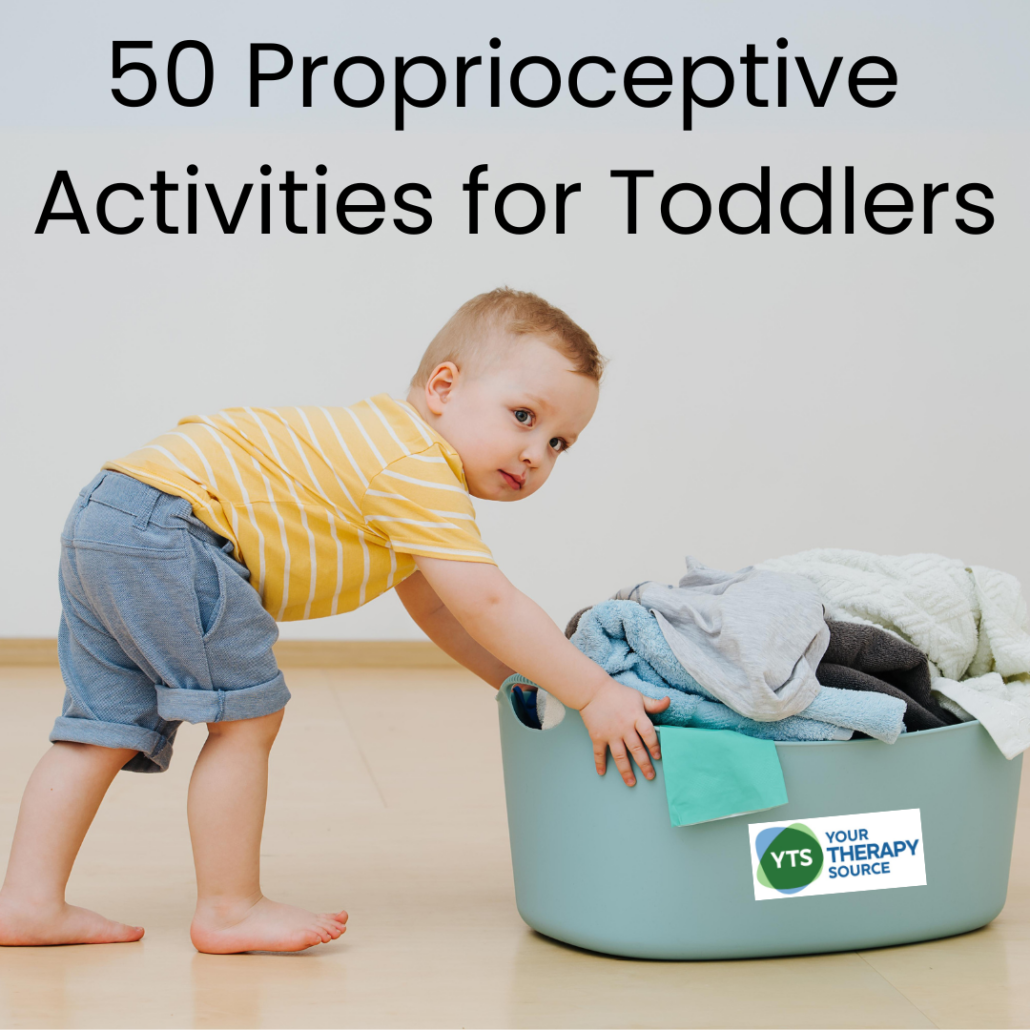Proprioceptive Activities for Toddlers

Understanding and engaging in proprioceptive activities for toddlers can be incredibly beneficial for their development. Proprioception, often referred to as the “sixth sense,” involves the body’s ability to sense its position, movement, and force of muscles and joints. Learn more about various proprioceptive activities for toddlers, how they benefit young children and practical ways to integrate sensory input into daily routines.
You can download a FREE handout of this article at the bottom of the post.
What is Proprioception?
Proprioception is the body’s ability to perceive its own position in space. This sensory system is essential for coordinating movements, maintaining balance, sensory modulation, and performing everyday tasks with all of the body parts. Sensory receptors in muscles, joints, and connective tissues provide the brain with vital information about body position and movement. Understanding proprioception can help parents and caregivers support their child’s sensory needs through appropriate activities and exercises. It works hand in hand with the vestibular system in the inner ear to provide sensory information to the brain. Often with children, you might hear proprioception be called heavy work or deep pressure activities in occupational therapy.
Why are Proprioceptive Activities for Toddlers Beneficial?
Proprioceptive activities for toddlers offer numerous benefits. These activities provide deep pressure and heavy work input, which can help calm and organize a child’s nervous system. Proprioceptive input can improve body awareness, enhance motor skills, and support self-regulation. Proprioceptive input activities are very important for a healthy “sensory diet” or “sensory lifestyle”. Engaging in these activities can lead to better coordination, improved focus, and reduced sensory-seeking behaviors for toddlers.

The Infant and Toddler Handbook
Functional Skills and Your Proprioceptive Sense – The Toddler Years
During the toddler years, children develop many functional skills that rely heavily on proprioception. Here are some examples of daily tasks:
- Drinking from a Cup: Learning to drink from a cup requires coordination and control of hand and arm movements.
- Balancing and Exploring Different Uneven Surfaces: Activities like walking on a balance beam or playing on various playground equipment enhance balance and spatial awareness.
- Swimming: This activity provides full-body proprioceptive input and helps with coordination and muscle strength.
- Learning to Get Dressed: Putting on clothes involves complex movements, fine motor skills, and body awareness, essential for developing independence.
- Obstacle Courses: Setting up simple obstacle courses at home can help toddlers practice navigating different types of movements and improve their proprioceptive sense.
50 Proprioceptive Activities for Toddlers
Incorporating simple proprioceptive activities into your toddler’s routine can be easy and fun. Here are 50 activities that can be done using materials from around the house, classroom, or outdoors. All activities should be supervised by an adult:
- Push a laundry basket filled with lightweight objects: Use items like small stuffed animals or soft toys to avoid making it too heavy.
- Jumping on a toddler-sized trampoline: Ensure the trampoline has safety handles and always supervise.
- Crawling through tunnels: Create tunnels with boxes or fabric play tunnels for a fun crawling adventure.
- Rolling a ball back and forth: Use a soft, lightweight ball to ensure safety.
- Carrying lightweight books: Choose thin, small books that are easy for toddlers to handle.
- Climbing stairs: Always supervise and assist as needed to ensure safety.
- Playing with play dough: Encourage squeezing, rolling, and shaping to enhance fine motor skills.
- Climbing up a slide: Allow climbing up a small slide with close supervision.
- Tug-of-war with a soft rope: Ensure the game is gentle and always supervised.
- Bouncing on an exercise ball: Have the child sit and bounce lightly while you hold the ball steady.
- Building with large blocks: Use big, lightweight blocks to stack and build.
- Stomping on bubble wrap: Lay out bubble wrap on the floor and let them stomp away.
- Rolling up in a heavy blanket: Gently wrap the child in a blanket and supervise to ensure they can breathe easily.
- Walking with a lightly weighted backpack: Use a backpack with very light weights, suitable for their size.
- Digging in a sandbox: Provide small tools for digging and pouring sand.
- Carrying lightweight grocery bags: Use empty or lightly filled bags for carrying.
- Completing a simple obstacle course: Set up soft obstacles like pillows and cushions to climb over and crawl under.
- Jumping into a pile of pillows: Ensure the pile is soft and safe for jumping.
- Pushing a toy lawnmower: A fun pretend-play activity that encourages pushing.
- Washing the car: Give them a small sponge and a bucket of water for some outdoor fun.
- Helping with household chores: Provide a small broom or cloth for sweeping or wiping tables.
- Animal walks (e.g., bear crawl, crab walk): Encourage them to imitate animal movements.
- Playing with a parachute: Lift and lower a small parachute or large sheet with a group of children.
- Yoga poses like downward dog: Simple poses can be introduced with guidance.
- Carrying a small watering can: Use a lightweight can for watering plants.
- Rolling a rolling pin over dough: Supervise them while they roll out soft dough.
- Pushing a toy stroller with weighted dolls: Ensure the stroller and dolls are light enough for safe pushing.
- Playing with kinetic sand: Provides great tactile input and is safe for little hands.
- Carrying a small bucket of water: Use a light bucket with a manageable amount of water.
- Throwing and catching a lightweight ball: Use a soft ball for safe throwing and catching.
- Playground Activities: Ensure the climbing equipment is appropriate for their age and always supervise.
- Walking on uneven surfaces: Grass, foam mats, or other safe, uneven surfaces can be used.
- Pushing against a wall: Encourage them to push gently against a wall for resistance.
- Carrying a small laundry basket: Lightly fill a small basket with soft items.
- Pushing a sibling on a swing: If the swing and sibling are light, always supervise.
- Playing with a weighted stuffed animal: Ensure the weight is appropriate for their size.
- Gardening activities: Use small tools for digging and planting.
- Jumping games: Use hula hoops or chalk circles for hopping in and out.
- Yoga and physical activity videos for toddlers: Follow along with simple, age-appropriate movements.
- Balancing on a curb: Supervise them as they balance on a low, safe curb.
- Pushing a broom: Provide a child-sized broom for sweeping.
- Gymnastics: Simple activities like somersaults or balancing on soft mats.
- Pushing heavy toys in a wagon: Ensure the toys are not too heavy and the wagon is stable.
- Playing with shaving cream: Supervised play with shaving cream can provide tactile input.
- Helping to set the table: Carrying lightweight plates and utensils to set the table.
- Swinging on a hammock: Gently rocking in a hammock with supervision. This provides vestibular input too!
- Marching to music: Encourage them to march and move rhythmically to songs.
- Playing hopscotch or Other Simple Jumping Games: Use chalk to create a simple hopscotch grid for jumping fun.
- Stacking and knocking down blocks: Use large, lightweight blocks for stacking and knocking over.
- Scooping and pouring activities: Use cups and bowls for scooping and pouring dry materials like rice or beans (with supervision).

Sensory Strategies Workbook
More Fun Stuff for Toddlers
For more engaging activities that support your toddler’s sensory and motor development, check out these resources:
- Emotional Activities for Toddlers
- Sensory Activities for Toddlers
- Outdoor Activities for Toddlers
- Fine Motor Activities for Toddlers
- Self-Regulation Activities for Toddlers
- Gross Motor Activities for Toddlers
What If My Toddler Has Poor Proprioception?
If you suspect that your child has poor proprioception or sensory processing disorder, it’s essential to understand the signs and seek appropriate support. Poor proprioception, sometimes referred to as proprioceptive dysfunction, can manifest in various ways, affecting a child’s ability to perform everyday tasks and regulate their sensory input.
Signs of Poor Proprioception
Children with poor proprioception may exhibit the following signs:
- Clumsiness: Frequent tripping, falling, or bumping into objects.
- Difficulty with Fine Motor Skills: Challenges in tasks like buttoning clothes, using utensils, or scribbling.
- Lack of Body Awareness: Struggling to understand where their body is in space, leading to awkward movements.
- Seeking Sensory Input: Engaging in activities that provide deep pressure or heavy work, such as crashing into objects, chewing on non-food items, or squeezing into tight spaces.
- Difficulty with Coordination: Struggling with tasks that require coordination, such as climbing or using simple playground equipment.
- Poor Posture: Slumping or difficulty sitting upright for extended periods.
- Behavioral Issues: Frustration, tantrums, or withdrawal from activities that require proprioceptive input.
Supporting a Child with Poor Proprioception
If your child shows signs of poor proprioception, here are some steps you can take to support them:
- Consult an Occupational Therapist: An occupational therapist can assess your child’s proprioceptive system and create personalized sensory strategies to address their specific needs. This may include proprioceptive input activities tailored to your child’s requirements.
- Incorporate Proprioceptive Activities: Integrate activities that provide deep pressure and heavy work into your child’s daily routine. Activities like carrying heavy objects, pushing or pulling weighted items, and climbing can help improve their proprioceptive sense.
- Use Sensory Tools: Tools such as weighted blankets, vests, or lap pads can provide additional proprioceptive input, helping your child feel more grounded and secure.
- Create a Sensory-Friendly Environment: Ensure that your child’s environment supports their sensory needs. This might involve using calming colors, reducing clutter, and providing sensory breaks throughout the day.
- Encourage Physical Play: Activities that involve running, jumping, climbing, and other forms of physical play can help improve proprioception. Playgrounds, obstacle courses, and sports can be beneficial.
- Be Patient and Supportive: Children with poor proprioception may need extra time and practice to develop their skills. Offer encouragement and celebrate their progress, no matter how small.
Proprioceptive activities for toddlers are a great way to enhance their sensory system, improve body awareness, and develop essential motor skills. Parents and caregivers can support their child’s overall development and well-being by incorporating these activities into daily routines. Remember to always supervise your child during these activities and consult an occupational therapist if you have any concerns about your child’s proprioceptive system. Engaging in these fun and beneficial activities will help your toddler thrive and enjoy exploring the world around them.
Download your FREE Handout of this Post
Enter your email in the form below to get access to the free PDF version of the article. A new tab will open with the PDF.



